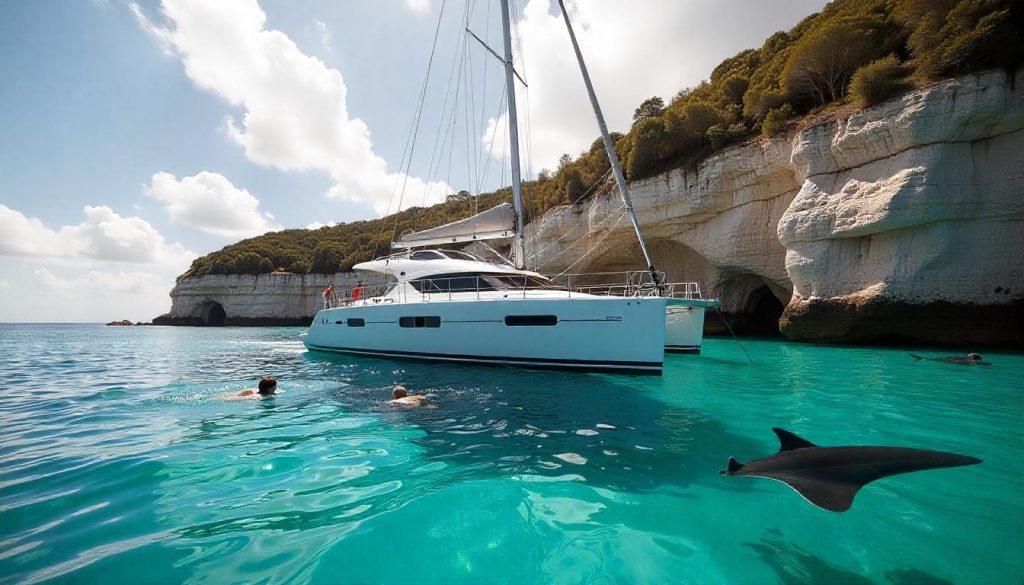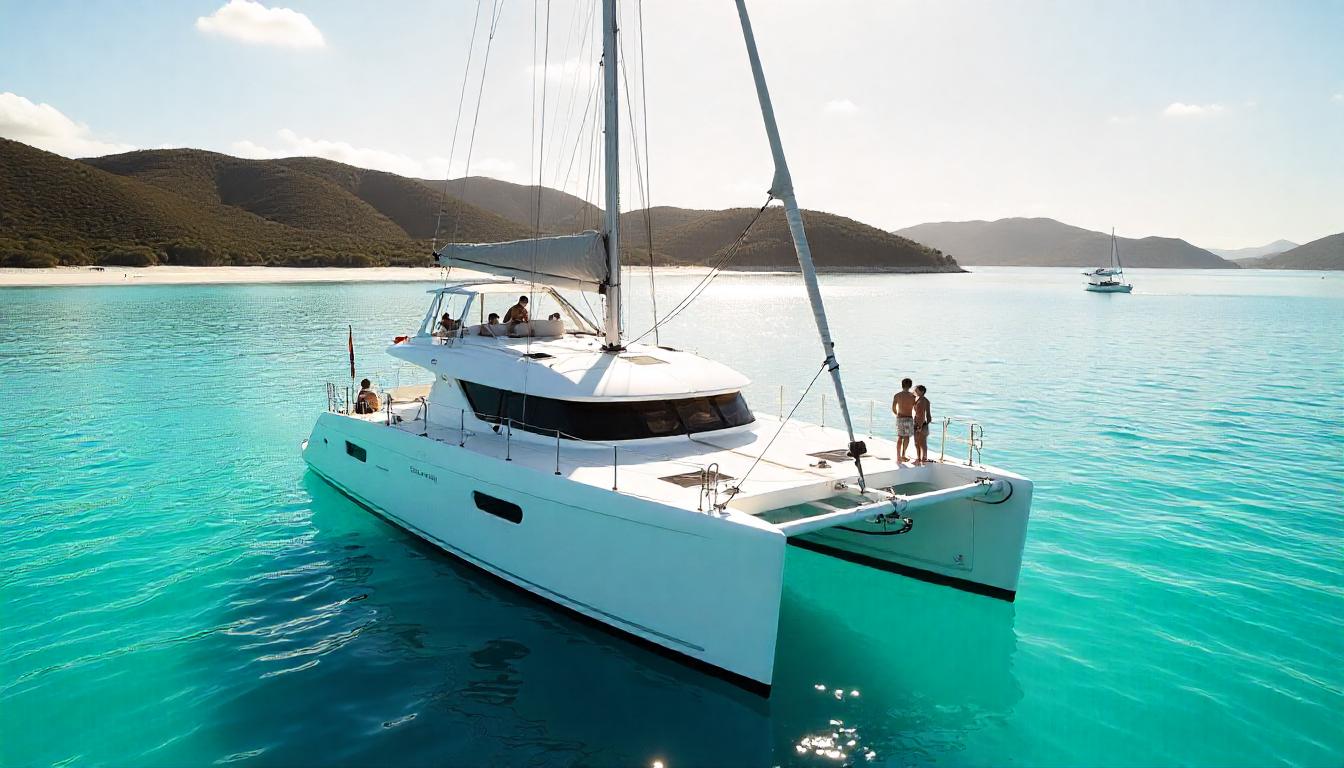The Whitsunday Islands, a cluster of 74 tropical gems in the heart of Australia’s Great Barrier Reef, are a sailor’s dream, and a Whitsundays sailing paradise in 2025 offers an unforgettable escape into turquoise waters and lush landscapes. Located off Queensland’s coast, this archipelago boasts some of the world’s most pristine beaches, vibrant coral reefs, and diverse marine life, including humpback whales and sea turtles. The waters here average 26°C in summer, per marine data, making them ideal for sailing, snorkeling, and swimming. In this guide, we’ll explore the best destinations, share scenic routes, and provide practical tips for yachters. Let’s set sail into Australia’s tropical haven.
Airlie Beach: The Gateway to a Whitsundays Sailing Paradise
Airlie Beach, the mainland hub for the Whitsundays, serves as the perfect gateway for a Whitsundays sailing paradise, offering a vibrant base for sailors. Begin at Coral Sea Marina, a modern facility in Airlie Beach. For example, Coral Sea Marina accommodates yachts up to 60 meters, with 520 berths and depths of 4-6 meters, per port data. Also, the marina provides fuel, water, and provisioning services. You can explore Airlie’s markets, where vendors sell local mangoes for $3 each, reflecting the tropical vibe, per vendors. The area’s winds average 8 knots, per forecasts. Thus, Airlie Beach is an ideal starting point for your Whitsundays adventure.
Airlie Beach Lagoon: A Pre-Sail Relaxation Spot
Airlie Beach Lagoon, a man-made swimming area, offers a pre-sail relaxation spot for yachters. A short walk from Coral Sea Marina brings you to this lagoon, with free entry, per guides. For instance, the lagoon’s waters are maintained at 26°C, perfect for a refreshing dip, per local data. Also, the surrounding park has shaded areas with barbecues, ideal for a picnic, per visitors. You can grab a coffee from nearby cafes for $5, enjoying the laid-back atmosphere, per menus. Moreover, the lagoon’s proximity to the marina makes it a convenient stop, per locals. This relaxing spot sets the tone for your journey. Therefore, it’s a great place to unwind before sailing.
Shute Harbour: A Scenic Departure Point
Shute Harbour, a 10-minute drive from Airlie Beach, provides a scenic departure point for sailors. For example, the harbour offers mooring for yachts up to 40 meters, with depths of 4-6 meters, per charts. Also, the area’s waters average 26°C, with visibility up to 15 meters, per reports. You can tender to shore and enjoy views of the Whitsunday Passage, a key sailing route, per guides. Additionally, the harbour’s jetty has a small cafe serving fish and chips for $15, per menus. The surrounding hills, covered in eucalyptus, create a stunning backdrop, per visitors. This picturesque spot makes Shute Harbour a standout. Thus, it’s an excellent alternative departure point for your Whitsundays trip.
Whitehaven Beach: The Jewel of a Whitsundays Sailing Paradise
Whitehaven Beach, on Whitsunday Island, is the jewel of a Whitsundays sailing paradise, renowned for its pure silica sand and turquoise waters. Anchor in Tongue Bay in depths of 5-7 meters, suitable for yachts up to 50 meters, per charts. For instance, the beach’s sand is 98% silica, staying cool underfoot even in 30°C heat, per park data. Also, the waters average 26°C, ideal for swimming, with visibility up to 30 meters, per reports. The area’s winds average 7 knots, ensuring a calm anchorage, per forecasts. Thus, Whitehaven Beach is a must-visit for every sailor in the Whitsundays.
Hill Inlet Lookout: A Panoramic Viewpoint
Hill Inlet Lookout, at the northern end of Whitehaven Beach, offers a panoramic viewpoint for yachters. A 20-minute hike from Tongue Bay leads to this lookout, with no entry fee, per guides. For example, the swirling sands of Hill Inlet create a mesmerizing pattern with the tides, per visitors. Also, the trail passes through bushland, where you might spot a lace monitor lizard, per locals. You can capture photos of the inlet’s turquoise swirls, a signature Whitsundays scene, per guides. Moreover, the early morning light enhances the colors, making it a prime time to visit, per advice. This breathtaking view makes Hill Inlet a highlight. Therefore, it’s a must-do for sailors at Whitehaven Beach.
Betty’s Beach: A Secluded Alternative
Betty’s Beach, a smaller cove near Whitehaven, provides a secluded alternative for yachters seeking solitude. For instance, the cove’s waters average 26°C, perfect for snorkeling, with visibility up to 25 meters, per reports. Also, the beach is less crowded, offering a private escape, per visitors. You can anchor in depths of 4-6 meters, suitable for yachts up to 40 meters, per charts. Additionally, the surrounding coral bommies host clownfish and parrotfish, per marine guides. This hidden gem makes Betty’s Beach a standout. Thus, it’s a great spot for sailors craving peace near Whitehaven.
Hamilton Island: A Bustling Stop in the Whitsundays
Hamilton Island, one of the few inhabited islands, offers a bustling stop for sailors exploring the Whitsundays, with modern amenities and natural beauty. Dock at Hamilton Island Marina, which accommodates yachts up to 60 meters. For example, the marina has 240 berths and depths of 5-7 meters, per port data. Also, berthing fees average $80 per night for a 40-meter yacht, per tariffs. The marina provides fuel, Wi-Fi, and provisioning, per guides. The waters average 25°C, per reports. Thus, Hamilton Island is a key destination for yachters seeking convenience.
Catseye Beach: A Family-Friendly Shoreline
Catseye Beach, on Hamilton Island, offers a family-friendly shoreline for yachters. A short walk from the marina leads to this beach, with free access, per guides. For instance, the beach’s waters average 25°C, ideal for swimming, with visibility up to 15 meters, per reports. Also, the beach has kayak rentals for $30 per hour, perfect for exploring the bay, per operators. You can spot green sea turtles near the shore, a common sight, per locals. Moreover, the beach’s cafes serve tropical smoothies for $8, per menus. This vibrant spot makes Catseye Beach a highlight. Therefore, it’s a great stop for sailors on Hamilton Island.
Passage Peak: A Hike with Stunning Views
Passage Peak, the highest point on Hamilton Island, provides a hike with stunning views for yachters. The 2.5-kilometer trail takes about 90 minutes round trip, with no entry fee, per guides. For example, the summit offers 360-degree views of the Whitsunday Passage, per visitors. Also, the trail passes through bushland, where you might see a koala, per locals. You should wear sturdy shoes, as the path can be rocky, per advice. Additionally, the sunrise from the peak casts a golden glow over the islands, per guides. This scenic hike makes Passage Peak a standout. Thus, it’s a rewarding excursion for sailors on Hamilton Island.

Hook Island: A Marine Haven in the Whitsundays
Hook Island, a less-visited gem, offers a marine haven for sailors exploring the Whitsundays, with vibrant coral reefs and tranquil anchorages. Anchor in Nara Inlet in depths of 4-6 meters, suitable for yachts up to 40 meters, per charts. For instance, the inlet’s waters average 26°C, with visibility up to 25 meters, per reports. Also, the area’s winds average 6 knots, ensuring a peaceful stop, per forecasts. The inlet’s cliffs feature Aboriginal rock art, accessible by tender, per park rules. Thus, Hook Island is a top destination for nature lovers.
Luncheon Bay: A Snorkeling Hotspot
Luncheon Bay, on Hook Island, offers a snorkeling hotspot for yachters. For example, the bay’s coral gardens teem with giant clams and reef fish, per marine guides. Also, the waters average 26°C, ideal for snorkeling, with visibility up to 30 meters, per reports. You can dive with a local operator for $90 per person, including gear, per operators. Moreover, the bay’s calm waters make it suitable for beginners, per guides. This vibrant underwater world makes Luncheon Bay a highlight. Therefore, it’s a must-visit for sailors on Hook Island.
Stonehaven Anchorage: A Quiet Retreat
Stonehaven Anchorage, also on Hook Island, provides a quiet retreat for yachters seeking solitude. For instance, the anchorage’s waters average 26°C, with visibility up to 20 meters, per reports. Also, the area is surrounded by steep cliffs and lush forest, creating a serene setting, per visitors. You can anchor in depths of 5-7 meters, suitable for yachts up to 50 meters, per charts. Additionally, the nearby reefs host manta rays, often spotted in the early morning, per locals. This peaceful spot makes Stonehaven a standout. Thus, it’s a great escape for sailors in the Whitsundays.
Practical Tips for a Whitsundays Sailing Paradise
A Whitsundays sailing paradise in 2025 requires careful planning for a safe and enjoyable journey. For example, the best time to sail is May to October, the dry season, when temperatures average 25°C, per Australian climate data. Also, book marina berths in advance, especially at Hamilton Island, as spaces fill up during peak season, per port advice. You should carry updated charts, as reefs near Hook Island can be hazardous, per data. Additionally, pack reef-safe sunscreen to protect the marine ecosystem, per environmental guidelines. Thus, preparation ensures a seamless sailing experience.
Best Time to Sail the Whitsundays
Timing your sailing trip enhances your Whitsundays experience. May to October offers the best conditions, with dry weather and cooler temperatures, per forecasts. For instance, August is ideal for visiting Whitehaven Beach, with minimal rain, per data. However, the wet season, November to April, brings cyclones, increasing risks around Nara Inlet, per reports. Also, the shoulder months, May and October, have fewer crowds, making anchorages like Stonehaven quieter, per guides. Winds average 5-15 knots during the dry season, per forecasts. Therefore, the dry season is the best time for sailing.
Navigating the Whitsundays Safely
Navigating the Whitsundays safely ensures a worry-free trip. For example, shallow reefs near Luncheon Bay require updated charts, as depths can drop to 2 meters, per data. Also, local guides in Airlie Beach cost $100 per day, helping navigate tricky areas like the Whitsunday Passage, per guidelines. You should monitor VHF channel 16 for weather updates, as fines for non-compliance can reach $200, per Australian law. Additionally, avoid anchoring on coral to protect marine life, per regulations. This preparation keeps your journey smooth. Thus, navigation tools and local expertise are essential.
Conclusion: Whitsundays Sailing Paradise in 2025
A Whitsundays sailing paradise in 2025 offers an unrivaled tropical adventure. Airlie Beach provides a vibrant start with Coral Sea Marina. Whitehaven Beach dazzles with its silica sands, while Hamilton Island blends luxury with nature at Catseye Beach. Hook Island offers a marine escape with Luncheon Bay. Also, careful planning ensures a safe journey through these turquoise waters. Thus, set sail in 2025 and discover why the Whitsundays remain Australia’s tropical paradise, combining natural beauty and serenity in one extraordinary trip.

 Navigare nelle Whitsundays: Il paradiso tropicale dell'Australia">
Navigare nelle Whitsundays: Il paradiso tropicale dell'Australia">
